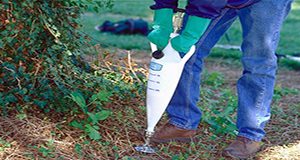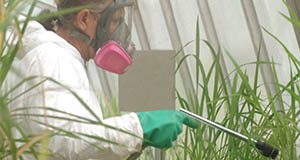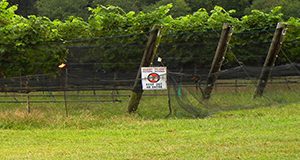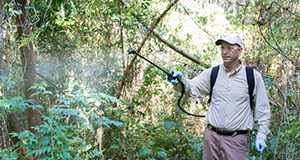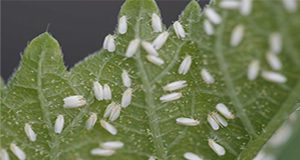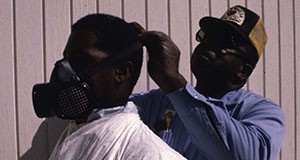Bromacil is a general use pesticide that is marketed in Florida under many names and is used on sites such as citrus, pineapple, and industrial areas. This 2-page document discusses the characteristics and use of bromacil. Written by Frederick M. Fishel and published by the UF/IFAS Agronomy Department, May 2018.
http://edis.ifas.ufl.edu/pi112
Category: Pesticide Information
Assessment-based Pest Management of German Cockroaches
Assessment-based pest management emphasizes the importance of evaluating the intensity of a pest problem before treating the problem. This 10-page fact sheet written by F.M. Oi, E. Weeks, J. Jonovich, and D. Miller and published by the UF/IFAS Entomology and Nematology Department explains the strategy and includes a decision flow chart to provide an easy-to-follow overview on how a German cockroach problem can be assessed and successfully managed with specific guidance for each of four levels described in the fact sheet. The levels described constitute an escalation protocol that may approximate the tiers in a LEED (Leadership in Energy and Environmental Design) pest-management plan and may meet the requirements of some “green” pest-management certification programs, depending on level.
http://edis.ifas.ufl.edu/in1190
Efficacy of Herbicide Active Ingredients Against Aquatic Weeds
Weed control is often a critical component of aquatic vegetation management in Florida waters. While physical, mechanical, and biological controls are utilized where they are feasible, herbicides are the primary tool used to control many troublesome species. This document answers some common questions and provides efficacy information for all herbicide active ingredients labeled for aquatic use in Florida. Written by S. F. Enloe, M. D. Netherland, W. Haller, and K. Langeland, and published by the UF/IFAS Agronomy Department, revised February 2018.
http://edis.ifas.ufl.edu/ag262
Pesticide Injection and Drenching
Drenching and injection are two pesticide application methods that are particularly effective in controlling some of the most troublesome insect pests of ornamental landscape trees. This 4-page document describes the equipment and procedures you will need to carry out either of these methods. Written by Frederick M. Fishel and published by the UF/IFAS Agronomy Department, January 2018.
http://edis.ifas.ufl.edu/pi274
Worker Protection Standard: Requirements for Commercial Pesticide Handler Employers
In 1992, the US Environmental Protection Agency issued a comprehensive regulation called the Worker Protection Standard for Agricultural Pesticides (WPS). The EPA has made several changes to the WPS since it was fully implemented in 1995. This 5-page document will address the WPS protections commercial pesticide handler employers must provide to their handlers. Written by Frederick M. Fishel and published by the UF/IFAS Agronomy Department, January 2018.
http://edis.ifas.ufl.edu/pi275
Worker Protection Standard: Requirements for Agricultural Employers of Workers and Handlers
Safety is a high concern for agricultural employers whose workers deal with hazardous materials, such as pesticides. In 1992, the US Environmental Protection Agency (EPA) issued the Worker Protection Standard for Agricultural Pesticides (WPS), a regulation that requires agricultural employers to take steps to reduce pesticide-related risks for their workers and handlers. This five-page document describes the responsibilities of employers who must adhere to the WPS. Written by Frederick M. Fishel and published by the UF/IFAS Agronomy Department, January 2018.
http://edis.ifas.ufl.edu/ag417
Worker Protection Standard: Additional Requirements for Agricultural Employers of Workers
The Worker Protection Standard (WPS) Act for Agricultural Pesticides was established by the US Environmental Protection Agency in 1992 and has undergone several revisions since. Recent revised provisions became effective in January 2017. This document will address the additional requirements for agricultural employers of workers under the revised WPS. Written by Frederick M. Fishel and published by the UF/IFAS Agronomy Department, December 2017.
http://edis.ifas.ufl.edu/pi273
Worker Protection Standard: Determining Your WPS Responsibilities
In 1992, the US Environmental Protection Agency (EPA) issued a comprehensive regulation called the Worker Protection Standard for Agricultural Pesticides (WPS). The EPA has made several changes to the WPS since it was fully implemented in 1995. This five-page document will address determining responsibilities under the revised WPS. Written by Frederick M. Fishel and published by UF’s Agronomy Department, September 2017.
http://edis.ifas.ufl.edu/ag418
2012–2016 On-Farm Evaluation of Fungicide Programs for Peanut Disease Control in Hamilton County, Florida
This seven-page fact sheet includes a summary of various fungicide spray programs for fungal disease control of early leaf spot, late leaf spot, and white mold/stem rot of peanut in 2012-2016 on-farm trials in Hamilton County. Written by K.W. Wynn, N.S. Dufault, and R.L. Barocco and published by the Plant Pathology Department.
http://edis.ifas.ufl.edu/pp334
Whitefly (Bemisia tabaci) Management Program for Ornamental Plants
Silverleaf whitefly is one of the most notorious invasive arthropods worldwide. It feeds on more than 900 plant species and vectors over 100 plant-damaging viruses. This 10-page fact sheet written by Vivek Kumar, Cristi Palmer, Cindy L. McKenzie, and Lance Osborne and published by the Department of Entomology and Nematology provides management recommendations, strategies for detection and scouting, and advice about control measures for this pernicious pest.
http://edis.ifas.ufl.edu/in1171
Worker Protection Standard: Respirators
On November 2, 2015, the EPA revised the WPS, making significant changes to the rule’s requirements. Most of the revised provisions became effective January 2, 2017; there are four provisions that are delayed until January 2, 2018. This four-page document will address respirator use under the revised WPS. Written by Frederick M. Fishel and published by the Agronomy Department and the Pesticide Information Office.
http://edis.ifas.ufl.edu/pi272
Pesticide Labeling: Protection of Pollinators
On May 29, 2015, the EPA published its Proposal to Mitigate Exposure to Bees from Acutely Toxic Pesticide Products. This seven-page fact sheet outlines the highlights from this policy and its proposed restrictions, which would prohibit applications of pesticide products that are acutely toxic to bees during bloom where honey bees are known to be present under contract for pollination services. Written by Frederick M. Fishel, James Ellis, and Gene McAvoy and published by the Agronomy Department.
edis.ifas.ufl.edu/pi271
Quick Reference Guide to the Worker Protection Standard (WPS) as Revised in 2015
The Worker Protection Standard (WPS) is a regulation originally issued by the US Environmental Protection Agency (EPA) in 1992 and most recently revised in 2015. This eight-page reference guide gives an overview of the 2015 revisions. Written by Frederick M. Fishel, and published by the Agronomy Department.
http://edis.ifas.ufl.edu/pi270
Worker Protection Standard: Training Workers and Handlers under the 2016 Revision Requirements
In 1992, the US Environmental Protection Agency (EPA) issued a comprehensive regulation called the Worker Protection Standard for Agricultural Pesticides (WPS). The EPA has made several changes to the WPS since it was fully implemented in 1995. On November 2, 2015, the EPA revised the WPS, making significant changes to the rule’s requirements. Most of the revised provisions will become effective January 2, 2017; there are four provisions that are delayed until January 2, 2018. This five-page fact sheet answers questions regarding changes made to the rules about how to train Workers and Handlers. Written by Frederick M. Fishel and published by the Agronomy Department.
http://edis.ifas.ufl.edu/pi268
Worker Protection Standard: Certified Crop Advisor Exemption
In 1992, the US Environmental Protection Agency (EPA) issued a comprehensive regulation called the Worker Protection Standard for Agricultural Pesticides (WPS). The EPA has made several changes to the WPS since it was fully implemented in 1995. On November 2, 2015, the EPA made significant changes to the rule’s requirements. Most of the revised provisions will become effective January 2, 2017 and there are four provisions that are delayed until January 2, 2018. This five-page fact sheet answers questions regarding changes made to the exemptions for Certified Crop Advisors. Written by Frederick M. Fishel and Tatiana Sanchez and published by the Agronomy Department.
http://edis.ifas.ufl.edu/pi265
Worker Protection Standard: Notification and Hazard Communication
In 1992, the US Environmental Protection Agency (EPA) issued a comprehensive regulation called the Worker Protection Standard for Agricultural Pesticides (WPS). The EPA has made several changes to the WPS since it was fully implemented in 1995. On November 2, 2015, the EPA made significant changes to the rule’s requirements. Most of the revised provisions will become effective January 2, 2017 and there are four provisions that are delayed until January 2, 2018. This five-page fact sheet answers questions regarding changes made to the rules about notification and hazard communication. Written by Frederick M. Fishel and Tatiana Sanchez, and published by the Agronomy Department.
http://edis.ifas.ufl.edu/pi266
Worker Protection Standard: Information at a Central Location
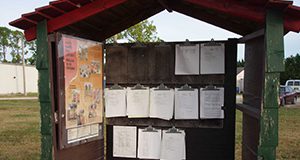
This three-page FAQ fact sheet answers questions about posting information at a central location per the regulations of the Worker Protection Standard (WPS).
Written by Frederick M. Fishel and Tatiana Sanchez and published by the Agronomy Department.
http://edis.ifas.ufl.edu/pi149
Worker Protection Standard: Owner and Immediate Family Exemption
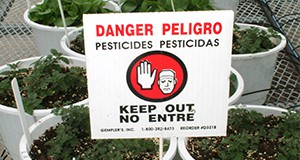
This three-page FAQ fact sheet answers questions about the exemptions for owners and their immediate families in the Worker Protection Standard (WPS).
Written by Frederick M. Fishel and Tatiana Sanchez and published by the Agronomy Department.
http://edis.ifas.ufl.edu/pi264
Worker Protection Standard: Personal Protective Equipment (PPE) 2016
In 1992, the US Environmental Protection Agency (EPA) issued a comprehensive regulation called the Worker Protection Standard for Agricultural Pesticides (WPS). The EPA has made several changes to the WPS since it was fully implemented in 1995. On November 2, 2015, the EPA made significant changes to the rule’s requirements. Most of the revised provisions will become effective January 2, 2017 and there are four provisions that are delayed until January 2, 2018. This five-page fact sheet answers questions regarding changes made to the rules about Personal Protective Equipment (PPE). Written by Frederick M. Fishel and published by the Agronomy Department.
http://edis.ifas.ufl.edu/pi267
Worker Protection Standard: Application Exclusion Zone (AEZ)

The Worker Protection Standard (WPS) is a Federal regulation designed to protect agricultural workers (people involved in the production of agricultural plants) and pesticide handlers (people mixing, loading, or applying pesticides or doing other tasks involving direct contact with pesticides).The “Application Exclusion Zone” or AEZ is a new term used in the WPS rule; it refers to the area surrounding the pesticide application equipment. This three-page fact sheet explains this new rule. Written by Fred M. Fishel and Tatiana Sanchez and published by the Agronomy Department.
http://edis.ifas.ufl.edu/pi263


